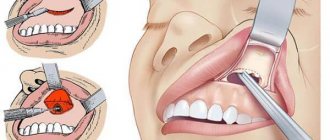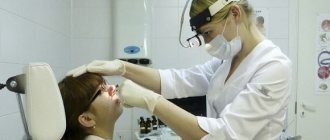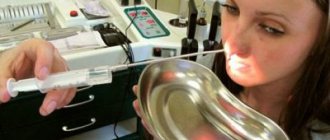What are the sinuses?
The paranasal sinuses, or sinuses, are cavities in the body of the bones of the facial part of the skull.
On the inside, they are lined with a mucous membrane, which normally produces mucus that slowly flows into the nasal cavities.
The sinuses are not hermetic formations, but they communicate with the external environment through just a few small openings - anastomoses.
The diameter of these holes does not exceed 1-2 mm, and they are located deep in the nasal cavities.
There are 4 groups of such sinuses:
- maxillary, or maxillary, located in the maxillary bone under each of the orbits;
- frontal, located above the eye sockets in the body of the frontal bone;
- lattice, located behind the bridge of the nose;
- sphenoid, located deep in the skull in the body of the sphenoid bone.
Due to this anatomical location and the narrowness of the excretory canals, there are, strictly speaking, no reliable ways to clear the sinuses at home. Directly inside the sinuses can only be penetrated with the help of medical manipulation. But it is quite possible to facilitate the removal of pus or mucus on your own.
Vasoconstrictors
The first task that needs to be solved to ensure flushing of the sinuses is the release of the excretory tract. Swelling of the mucous membrane of both the paranasal sinuses and the nasopharynx leads to the fact that these already small openings are completely blocked. Therefore, any other cleaning methods will not be effective if the purulent and mucous contents have nowhere to be removed, and the medicinal substances are not able to penetrate the sinuses.
The easiest way to relieve swelling is with the help of conventional pharmaceutical products that have a vasoconstrictor effect. These could be drugs such as naphthyzin, galazolin, etc. By narrowing the diameter of the vessels, they reduce their permeability to fluid, which leads to a rapid decrease in the swelling of the surrounding tissues.
How to properly rinse your nose for sinusitis: pharmacy and folk remedies
Some people do not want to use expensive medications for sinusitis and try to cure themselves with folk remedies. There are several effective folk remedies that will help overcome congestion.
Kalanchoe
You can cure the symptoms of a runny nose using medicinal drops prepared from fresh Kalanchoe juice. To prepare a medicinal product, it is recommended to use types of plants such as Bryophyllum and Degremona. To create a remedy for the common cold, 2-3 leaves are cut from the plant. They are then wrapped in a piece of dark cloth and placed in the refrigerator for three hours. This will improve the effectiveness of the drug several times.
Not everyone knows how to cleanse sinuses with Kalanchoe juice. To do this, you need to add three drops of juice mixed with water into each nasal passage for seven days, morning and evening. When treating adults, juice should be mixed with water in a one to one ratio. For children, such a solution will be too concentrated and therefore more water is added to the mixture.
Cranberry and ginger
It is no secret that during a severe runny nose, a person loses a large amount of fluid that the body needs. Metabolic products of bacteria and viruses dissolve in it, which improves nasal breathing and reduces congestion. Therefore, the patient should always be provided with plenty of fluids. To relieve congestion symptoms, it is recommended to drink tea made from ginger and cranberries.
To prepare the drink you will need 80 grams of cinnamon, 40 grams of ginger, 60 grams of cranberries and 500 ml of water. All this is thoroughly mixed and boiled for about 40 minutes. Then the liquid should infuse for another half hour. It is recommended to drink tea four times every day, 20 minutes before meals. The drink has a high tonic effect and therefore should not be drunk before bed.
Eucalyptus
An infusion made from marshmallow and eucalyptus leaves is considered a fairly effective folk remedy. To prepare a decoction, add 15 grams of eucalyptus leaves and 20 grams of marshmallow to 300 ml of hot water. All ingredients are boiled over low heat for about 20 minutes, after which they are filtered with gauze. It is recommended to drink the prepared product no more than three times a day.
What to wash with?
Sinusitis is a disease of the maxillary sinuses, accompanied by nasal congestion, copious discharge, swelling, and pain. Treatment of the disease is carried out in various ways. Often, rinsing of the nasal passages is used for therapy. Is it possible to do this? What benefits are there from this treatment?
Benefit:
- Mucous and purulent contents are removed,
- Harmful microorganisms are washed out of the nasal sinuses,
- The condition of blood vessels and capillaries is normalized,
- The protective functions of the mucous membrane are enhanced,
- Swelling decreases, congestion disappears,
- Drainage function is restored,
- The number of stagnation phenomena is reduced.
Nasal rinsing for sinusitis is carried out before using any medications. A similar action is necessary before surgical interventions.
You can rinse your nose in a hospital or at home, following the instructions. There are a variety of substances available to carry out therapy in this manner. What is the best way to rinse your nose to get rid of sinusitis?
For this procedure, different liquids are used - boiled water, medicinal liquids, herbal decoctions. Each medicine has a specific effect and has its own contraindications and side effects. Before undertaking this therapy, you should consult with a medical professional.
Folk remedies are ideal for rinsing the sinuses and nose at home. These recipes have been tested by several generations of people and have proven effectiveness and safety. The healing substances of plants help relieve inflammation, kill viruses and bacteria, and strengthen local immunity.
When using plant decoctions, you must make sure that they do not cause allergies.
List:
- chamomile – relieves inflammation.
- sage – the essential oils contained are anti-inflammatory and mild
- bactericidal effect.
- Kalanchoe – relieves inflammation, has an irritating effect.
- eucalyptus – expectorant effect.
- series - expectorant, antiviral and anti-inflammatory effect.
- calendula – relieves inflammation and disinfects.
Recipe: Brew a tablespoon of dry raw materials in one glass of boiling water. Keep in a water bath for 10 minutes and strain after half an hour.
Decoctions can be used to clear the sinuses by drawing in water through the nostrils. Cleaning the nose can be done up to 6 times a day.
Vegetable juices
It is recommended to use freshly squeezed onion, carrot and beet juice. When juice gets on the nasal mucosa, it causes irritation, which reflexively leads to sneezing and helps remove mucus. Juices can be instilled into the nose as drops. It is recommended to dilute onion with water.
How to clean your sinuses and rid yourself of many ailments
MOLDOVENII.MD
This is an extremely important, albeit unpleasant procedure.
In an adult, 1 to 2 glasses of pus accumulate in the 4 paranasal sinuses and the air-bearing bones (2 frontal and 2 maxillary) become a container for toxic products, instead of being carriers of light air ions that nourish the brain. Absorbed from the paranasal sinuses into the brain, where the respiratory center is located, purulent toxins support the neurohumoral mechanism of the pathological process.
Cleaning the paranasal sinuses involves instilling 1 drop of cyclamen tuber juice diluted with distilled water (you can buy this water for batteries at a car store) into each nostril. You need to peel the tuber white, wash it, grate it on a fine grater, squeeze the juice out of the pulp, pour it into a clean bottle, dilute it with distilled water in a ratio of 1:5 or 10-30 (depending on how you feel), the solution can be stored in the refrigerator for up to 10 days. Pour into a dark glass container and close tightly with a lid. Rinse the vessel and disinfect it three times with undiluted hydrogen peroxide.
Instillation is done extremely carefully in the morning on an empty stomach after a cleansing enema, lying on your back without a pillow. You need to lie down for 5-7 minutes. After this, you need to get up, bend down to the floor for 30 - 60 seconds, drink a hot herbal infusion of 200-600 ml and rinse your nose with hot water. From the 2nd or 3rd day, purulent discharge will come from the nose. It is necessary to instill 1-3 times or more (according to the condition) per day for 2-6 or more months daily, depending on the severity of the disease, this is the only way to thoroughly cleanse the sinuses of pus and get rid of the danger of renewed attacks.
This is an extremely important, albeit unpleasant procedure. Cleansing the frontal and maxillary sinuses with this drug is a 100% guarantee of preventing influenza and respiratory infections in general.
You can do inhalation with eucalyptus leaves, mint or fir oil, and star balm.
As a result, a huge amount of mucus and pus is released from the paranasal sinuses, located in the human head, which could become an excellent breeding ground for that same influenza virus, from which we cannot find protection. And the best defense is to prevent the virus from feeding on the pus in our body.
At times, nasal breathing may be disrupted and a feeling of stuffiness may appear. In this case, you need to continue digging. Further release of mucus will give you the opportunity to breathe freely. The feeling of breathing after clearing your sinuses is incomparable to anything and has probably been forgotten by you for a long time.
Along with these procedures, it is necessary to maintain the correct rhythm of sleep and wakefulness, that is, fall asleep at nine o'clock in the evening and wake up at five o'clock in the morning. The normal rhythm of sleep, corresponding to the solar biorhythm of a person, as part of the macrocosm, is very quickly restored during the treatment process and remains for life, because corresponds to the physiological ups and downs of the daily energy activity of the human body.
Sleep is more important for a person than food. During sleep, without spending the body's resources on digesting food, we receive the most valuable cosmic energy, which makes up 75% of our energy balance, completely free of charge. We obtain the rest of the energy partly from direct sunlight and partly from the breakdown of energy bonds in food products.
Author: Marva Ohanyan
Source: fithacker.ru
Inhalations with herbs
This is one of the indirect ways to clear the sinuses. But it will be effective only if all mucus is first removed from the nasal passages and the sinus openings are open.
To prepare the infusion, mix 2 tablespoons of dry chamomile, sage, eucalyptus, St. John's wort and lavender, as well as 1 tablespoon each of noble yarrow and string.
Take 3 tablespoons of the resulting mixture, place in an enamel or glass bowl and pour in 2 liters of boiling water. Close the dish with a lid, wrap it in a large towel and let it sit for 15 minutes. Then cover your head with a towel, lean over the container and inhale the vapors of the herbal infusion through your nose.
In addition, you can also inhale the vapors of calendula tincture, a few drops of which should be dissolved in boiling water. During such procedures, vapors of medicinal herbs will penetrate the nose and further into the paranasal sinuses. Cooling, the steam condenses on the inner surface of the sinuses and dilutes mucus and pus, ensuring easier and simpler removal through the anastomosis.
The effect of this procedure when rinsing the sinuses at home is based on the effect of the volatile components of propolis, which can penetrate the sinuses. You will need 2 teaspoons of propolis solution in alcohol, which is sold in pharmacies. Pour them into 2 liters of boiling water, and then immediately cover your head with a towel, lean over the pan and inhale the vapors. Another way to inhale propolis is to soak cotton swabs with its ointment, which should then be inserted into both nostrils for 5 minutes.
Remember that it is better not to use this method in young children, since almost all beekeeping products have an increased allergenic effect and can provoke unwanted reactions from the child’s physiologically immature immune system.
Clear your sinuses by flushing
Nasal rinses work amazingly well to remove dust, pollen, dirt, etc., and are a quick and effective method. If you do it correctly, it can also reduce the severity and frequency of sinus infections. Here's how to clear your sinuses through nasal rinses.
Preparation
You need to make some preparations before you start drowning your sinuses. Here are a few things to consider:
- Select the correct device. You can find many types of irrigation devices in stores, pharmacies and online. They are available in a variety of sizes and shapes, but the most common ones are syringes, neti pots and bulbs. Choose what suits you best.
- Prepare saline solution. You can make your own saline solution by mixing a teaspoon of salt and half a teaspoon of baking soda in half a liter of warm water. Do not use salt with iodine and preferably use distilled water.
- Sanitary precautions. You should take special care when using, cleaning and storing the irrigation device. Wash your hands before handling the device. You should also clean the device before and after each use with sterile or distilled water. Let it dry first and then use a disposable paper towel to wipe the inside dry.
Here are the steps on how to clear your sinuses with an irrigation device:
- Fill the device: You will need to fill the neti pot, syringe, or whatever device you are going to use. Make sure it is clean and dry. You can use your homemade saline solution for this purpose.
- Get into position: It's best to lean over the sink before you start rinsing your sinuses. Tilt your head – You can tilt it at a 45-degree angle to ensure the best flow of water. Bring the tip of the irrigation devices close to your nostril and press it gently.
- Sinus Irrigation : Once the tip is close to the top of the nostril, you can begin irrigating your sinuses. Be very careful if this is your first time. To avoid any problems, move slowly and breathe only through your mouth. Never try to breathe through your nose or it will send water into your lungs and cause complications. Raise the handle of the irrigation devices slowly to help the water flow into the nostril.
- Changing sides: After you have rinsed one side, you should switch to the other side. Repeat the same procedure for the other nostril. You just need to do it slowly and in a controlled manner to avoid any problems.
- Clear your sinuses: After you have cleared your sinuses, you should not inhale immediately. It is better to exhale through your nose first and then breathe through your nose.
Medicinal rinses
You can clean your nose with furatsilin or soda. Furacilin solution in silicone or glass packaging can be bought at a pharmacy or prepared from tablets. To do this, you need to dissolve 2 crushed furatsilin tablets in one glass of warm water. Before use, stir the solution well and strain. You can rinse the maxillary sinuses with furatsilin up to three times a day for one week.
To prepare a soda solution, dilute a teaspoon of soda in a glass of warm water. It is better to use not water, but a decoction of some medicinal plant (calendula, chamomile). If desired, sodium bicarbonate solution can be purchased at the pharmacy.
Soda does not replace salt, as it has no effect on swelling and inflammation. Soda has a different mechanism of action - it is involved in breaking down the bonds of thick, purulent mucus.
Clearing the nose with the Neti exercise
When rinsing the nose, the air sinuses are cleared, the brain is strengthened, the tone of the optic nerves is maintained and, therefore, vision improves. Neti method (taken from the yoga cleansing system): stir 1 teaspoon of salt (preferably sea salt) into 1/2 cup of water. Pour water into your palm and draw it in through one nostril. You can close the other nostril with your finger. Use your palms alternately for the corresponding nostrils. The drawn-in water will flow out through the same or the other nostril, or through both, or, more conveniently, through the mouth. Repeat this drawing in of water 2-3 times alternately through each nostril. In case of colds, rhinitis, etc., rinsing is done 2-3 times a day. You can rinse with infusions of antiseptic herbs (mint, St. John's wort, oregano, chamomile, etc.). The most important thing in Semenova’s method is the sequence of cleansing; you should always start with cleansing the intestines. When you do this regularly, it is enough to carry out a set of cleansing procedures once a year.
Add 150 g of grated horseradish to the juice of 3 lemons, mix everything well.
Take the resulting mixture 2 times a day, one teaspoon at a time, in the morning on an empty stomach and before bedtime.
This mixture helps dissolve mucus without damaging the membranes; it does not irritate the gallbladder, digestive tract, or kidneys, and is also a good diuretic for dropsy and swelling.
Salt rinses
The article describes how to rinse your nose with sinusitis, how to do it correctly, the advantages and disadvantages of basic solutions.
Washing plays a big role in alleviating the symptoms of inflammation of the maxillary sinus. It allows:
- cleanse the nasal cavity of mucus and pus accumulated there;
- quickly restore the functions of the respiratory epithelium;
- restore capillary tone and blood supply;
- improve the activity of the body’s protective immune reactions;
- restore physiological nasal breathing;
- improve the effectiveness of medications that can be applied topically after rinsing.
In a clinic setting, the procedure is performed with a special device under the supervision of an otolaryngologist. He may advise washing at home and give recommendations regarding individual solutions (both medicinal and natural).
It is contraindicated to rinse your nose under the following conditions:
- severe nasal congestion (risk of solution getting into the middle ear and developing acute otitis media);
- the patient's tendency to nosebleeds;
- curvature of the nasal septum (low effectiveness of the procedure);
- hypersensitivity to the rinsing solution;
- recent traumatic injury to the nose;
- the presence of neoplasms in the nasal cavity (polyps, tumors).
The disadvantage of the procedure is its ability to wash away the protein-fat film that is located on the surface of the respiratory epithelium, which makes it more vulnerable to pathogenic microorganisms. Therefore, before rinsing, you should definitely consult a qualified doctor.
The procedure must be carried out over a sink. For the procedure, you can use a syringe, a regular syringe, a sinus catheter or a special “teapot”. The solution should be warmed to body temperature (36-37°C). Below are step-by-step instructions for rinsing your nose:
- The patient stands over the sink and tilts his torso with his head at an angle of 90°.
- He turns his head to the side so that the nasal passages are in a vertical line.
- The tip of the instrument with the solution is carefully inserted into the upper nasal passage so as not to injure the mucous membrane.
- The patient breathes smoothly through his mouth.
- Next, he slowly releases the solution from a syringe or other device.
- If the procedure is performed correctly, the liquid flows along the back wall of the nasopharynx, and then enters the lower nasal passages and flows out of the opposite nostril.
- The position of the head changes to rinse the other nasal passage.
- After the procedure is completed, the patient blows his nose, removing any remaining solution, mucus, pus and blood.
Usually, during the first attempts, the patient’s rinsing liquid flows not only from the nose, but also enters the mouth. This is not something to be afraid of. With due diligence, after just a few attempts the patient manages to do everything correctly. After the procedure, you must refrain from going outside for an hour.
Helpful: Increased testosterone in women
Saline solution and preparations based on it are the most recognized and frequently used means for rinsing the sinuses at home. A weakly concentrated solution is suitable for use for preventive purposes, a concentrated solution is suitable for removing pus from the maxillary sinuses.
Types of saline solutions:
- Saline solution. An affordable product that contains a physiological concentration of salt. It thins mucus, soaks crusts, and washes away bacteria and viruses.
- Saline solution. You need to take sea salt. For preventive use, dilute one teaspoon of salt per 1 liter of water; to cleanse the maxillary sinuses of pus, dilute a level teaspoon of salt per glass of water. Sea salt has a number of beneficial properties that help cope with inflammation in the sinuses.
- Drops and sprays. There are many drops for rinsing the sinuses, from which you can choose the appropriate product, taking into account your financial capabilities.
To flush the sinuses from mucus, viruses, and prevent colds, you can use isotonic solutions (0.6–0.9%):
- Salin;
- Rinolux;
- No-salt;
- Humer isotonic;
- Otrivin Baby. Otrivin Baby and Humer are perfect for even the youngest patients.
To clean the sinuses from purulent contents, eliminate nasal congestion and swelling, it is necessary to use hypertonic solutions with a salt concentration of up to 2.6%:
- Kwix is a sales leader;
- Aqua Maris is a bestseller;
- Aqualor - there are several varieties of the drug, each selected according to the nature of the discharge;
- Humer is hypertensive;
- Dolphin, in addition to a unique complex of minerals, contains extracts of medicinal plants.
Saline solutions are widely used in cleaning the nasal cavities, but they can also be useful in removing contents from the paranasal sinuses.
Their action in this case will be based on the hygroscopic properties of salt - its ability to absorb and “pull out” any liquid fractions.
The liquid itself, of course, will practically not get into the sinus, but it will create specific chemical and physical conditions that enhance the removal of mucus.
You can use any salt solutions:
- Isotonic sodium chloride solution, or saline solution (9 grams of table salt per 1 liter of water)
- Dry sea salt solution (1 tablespoon per 1 liter of water)
- Concentrated saline solution (2 tablespoons of table salt per 0.5 liter of water)
- Ready-made salt mixtures purchased in pharmacies, etc.
Intensive rinsing
The essence of this technique is to deliver a large amount of medicinal substances into the nasal cavity and nasopharynx in the hope that at least some of them will penetrate into the sinuses.
Take a rubber bulb-syringe and fill it with antiseptic liquid. It can be:
- infusions of chamomile, St. John's wort or calendula;
- saline solutions;
- furatsilin;
- purchased medications, for example, chlorophyllipt, etc.
Then insert the tip of the syringe into the nostril and squeeze the bulb tightly. The stream of solution should penetrate deep into the nasal cavity.
This procedure is not recommended for children, since fluid under pressure can enter the inner ear and cause otitis media, and in addition, it can itself damage the nasal mucosa.
Cleansing mucous membranes
Vitaon cleansing
Vitaon is prescribed to cleanse all mucous membranes of the body. This is an excellent remedy for removing the accumulation of pus in the frontal sinuses - sinusitis. It is used for diseases of the nasopharynx: frontal sinusitis, adenoids, polyps, deviated nasal septum and others.
Vitaon composition
Add a dry mixture of mint, snuff, and eucalyptus in equal quantities until 1/3-1/4 of the volume of the prepared vessel is filled. Pour in olive oil (you can replace it with sunflower oil). Leave to infuse for 10-20 minutes. The mixture should turn green-brown in color. Leave it for storage in a dark place.
Procedure diagram
- Sit in a comfortable position and tilt your head so high that the prepared infusion does not pour out of your nostrils.
- Place 20-25 drops in each nostril and sit in this position for 5 minutes. During this time, beneficial substances from Vitaon will penetrate through the septum into the frontal sinus, where toxic substances from all parts of the brain enter. Here Vitaon neutralizes them and removes them through the nose. If you are sick with inflammation of the middle ear, then instill Vitaon in your ears several times a day, 2-3 drops.
"Cuckoo" method
This method is very effective, but it can only be carried out in a hospital. Catheters are inserted into the patient's nostrils, through one of which furatsilin is supplied under pressure, and through the other, the liquid that has passed through the nasal passages is intensively aspirated using a vacuum suction. Enhanced removal of pus and mucus from the sinuses is achieved here by creating a pressure difference in the sinus and nasal passages. Final cleaning will require 5-7 procedures.
The technique received its unusual name because during its implementation the patient must repeat the sound “ku-ku-ku” all the time.
This prevents the pharmacological drug supplied under pressure from flowing into the laryngeal cavity.









